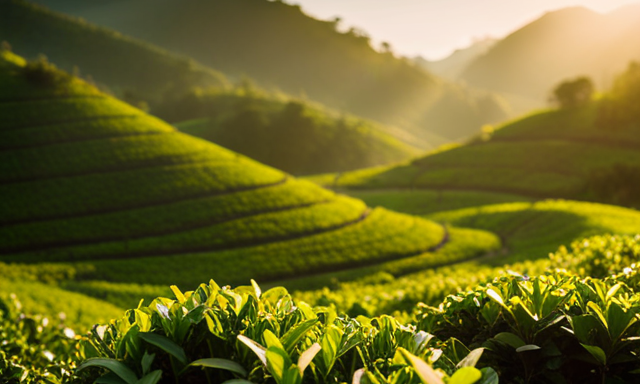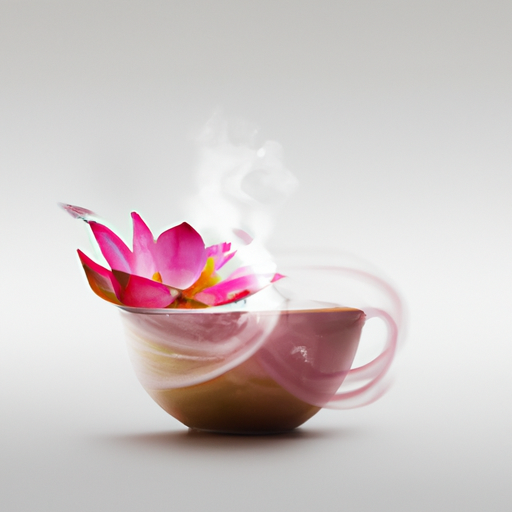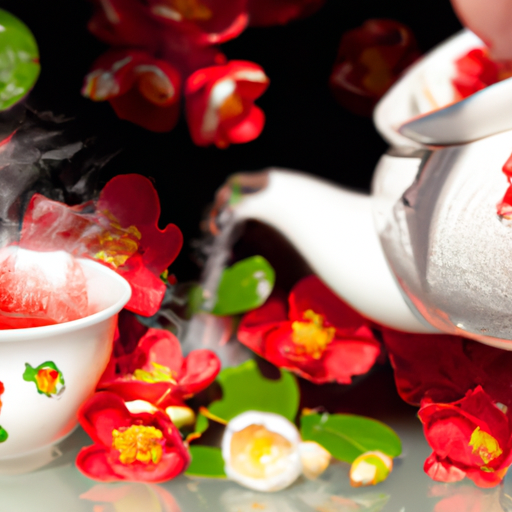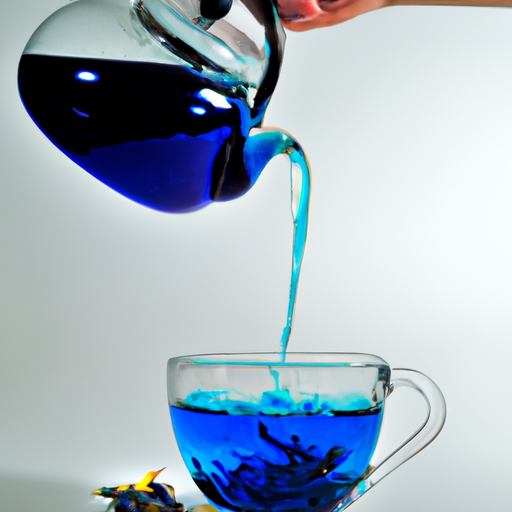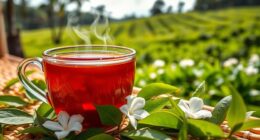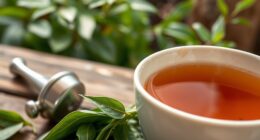Have you ever heard the theory that flowers have their own language? Well, I can confirm that it’s true. And what better way to let them communicate than by crafting a lovely flower arrangement for a delightful tea party?
Picture this: delicate petals dancing in the breeze, their vibrant colors whispering secrets of beauty and elegance. With just a few simple steps, you can transform a handful of blooms into a stunning centerpiece that will enchant your guests.
In this article, I’ll guide you through the process, from gathering your supplies to adding those final finishing touches. So, grab your apron and let’s dive into the magical world of floral artistry.
Get ready to unleash the language of flowers and create a masterpiece that will leave everyone in awe.
Key Takeaways
- Importance of selecting a focal flower that complements the theme
- Creating a framework with focal flower, secondary flowers, and greenery
- Arranging flowers by color palette and height for balance
- Adding finishing touches for a polished look
Gather Your Supplies
Now you gotta gather all your supplies to create a stunning little flower arrangement for your delightful tea party.
First things first, create a color palette that complements the theme of your party. Think pastel shades for a soft, feminine touch or vibrant hues for a lively atmosphere.
Next, choose the right vase for your arrangement. A small, dainty vase will work best for a tea party setting. Consider using a vintage teacup or a delicate glass jar to add a whimsical touch.
Don’t forget to gather some floral foam or a small piece of chicken wire to help secure your flowers in place.
With all your supplies ready, it’s time to move on to the next step and prepare your flowers for the arrangement.
Prepare Your Flowers
To prepare my flowers for the small flower arrangement at my tea party, I first trim the stems to ensure they fit nicely in the vase. With a sharp pair of scissors, I cut the stems at an angle, allowing them to absorb water more easily.
Next, I carefully remove any unwanted leaves or thorns that may detract from the overall beauty of the arrangement. This step not only enhances the aesthetic appeal but also prevents any unwanted scratches or pricks during handling.
Trim the Stems
After taming the wild stems with my mighty shears, they’re ready to be pruned to perfection for my dainty tea party flower arrangement.
To ensure a polished look, I employ various trimming techniques. First, I remove any excess foliage from the stems, focusing on retaining only the most vibrant leaves. This not only enhances the visual appeal but also prevents the arrangement from appearing overcrowded.
Next, I trim the stems at a slight angle, allowing for better water absorption and longevity. Choosing the right vase is crucial as well; a petite, elegant vessel complements the delicate nature of the tea party theme.
With the stems neatly trimmed and nestled in the perfect vase, my flower arrangement is ready to shine. As I move on to the next step of removing any unwanted leaves or thorns, my arrangement will exude grace and charm.
Remove Any Unwanted Leaves or Thorns
Get rid of any unwanted leaves or thorns to give your flower arrangement a clean and elegant look. Proper techniques for removing thorns and leaves from flower stems include using a sharp pair of floral shears or a knife to carefully cut them off. Be gentle to avoid damaging the stem.
As for the leaves, simply strip them off with your fingers, starting from the bottom and working your way up. Now, let’s get creative with those unwanted leaves and thorns! Instead of throwing them away, consider repurposing them. You can use thorns to create a unique textured effect in other floral arrangements or use the leaves to add a touch of greenery to table settings or as decoration for tea cups.
With the leaves and thorns taken care of, we can move on to creating a framework for our small flower arrangement.
Create a Framework
When creating a flower arrangement, it’s important to start with a focal flower that will catch the eye and set the tone for the arrangement. This can be a large, vibrant bloom or a unique and interesting flower that stands out.
Once the focal flower is in place, it’s time to add secondary flowers that complement and enhance the focal flower. These can be smaller blooms that provide color, texture, and shape to the arrangement.
Finally, fill in the gaps and add depth to the arrangement by incorporating greenery. This can be in the form of leaves, ferns, or other foliage that adds a touch of freshness and balance to the overall composition.
Start with a Focal Flower
First, I choose a beautiful focal flower for my small tea party arrangement. The focal flower is the star of the show, so I carefully select one that will capture everyone’s attention. I consider the size, color, and shape of the flower, making sure it complements the theme of my tea party.
Once I have chosen the perfect focal flower, I begin arranging it in my vase using various techniques. I trim the stem at an angle and remove any excess leaves. Then, I place the focal flower in the center of the vase, making sure it stands tall and proud.
As I admire the beauty of my focal flower, I can’t wait to add secondary flowers to complete my tea party arrangement.
Add Secondary Flowers
Once I’ve found the perfect focal flower, I can’t help but go all out and add an extravagant array of secondary flowers to my arrangement. The secondary flower selection is crucial in creating a visually appealing and dynamic arrangement.
I love incorporating a variety of colors to complement the focal flower. I look for flowers that have different shapes, sizes, and textures to create interest and depth. I might choose delicate roses in soft pink, vibrant daisies in yellow and orange, and elegant lilies in white. By carefully selecting secondary flowers that harmonize with the focal flower, I can create a stunning visual display that will surely impress my guests at the tea party.
Now, to complete the arrangement, it’s time to fill in with greenery, adding a touch of freshness and natural beauty.
Fill in with Greenery
To really enhance the overall look and bring a touch of natural beauty to your arrangement, don’t forget to add an abundant amount of vibrant greenery. The greenery selection is just as important as the flowers themselves.
Look for different types of foliage that have interesting shapes, textures, and shades of green. This will add depth and dimension to your arrangement. Start by cutting the stems of the greenery at an angle to ensure they can drink water effectively. Then, arrange the greenery around the base of the vase, allowing it to drape over the edges and create a lush backdrop for the flowers.
The greenery acts as a foundation for the arrangement, providing a cohesive and visually pleasing background.
Now that we have our greenery in place, let’s move on to arranging the flowers.
Arrange the Flowers
When arranging the flowers, you’ll be surprised to learn that using a variety of colors can increase the visual appeal of your arrangement. Not only does it add depth and interest, but it also creates a unique centerpiece that will be the talk of your tea party.
To achieve this, start by choosing the right color palette. Consider the theme and mood of your event, and select flowers that complement each other in terms of hue and tone. Incorporate soft pastels for a delicate and feminine touch, or go bold with vibrant blooms for a more striking arrangement. Remember, the key is to create a harmonious blend that catches the eye.
Now that you have selected your flowers and greens, it’s time to arrange them in your vase or container. Begin by placing the tallest flowers in the center, and then work your way outwards, alternating colors and heights. This will create a balanced and visually pleasing arrangement.
Finally, add finishing touches to complete the look and add a touch of elegance.
Add Finishing Touches
Now that the flowers are arranged, it’s time to add the finishing touches to make the arrangement truly stunning.
First, I trim any excess stems or foliage that may be sticking out or overcrowding the arrangement. This helps create a cleaner and more polished look.
Next, I carefully adjust the arrangement for balance and symmetry, ensuring that no one flower or foliage is overpowering the others.
Finally, I add water to the vase or container to keep the flowers fresh and vibrant for the duration of the tea party.
These final steps are crucial in perfecting the flower arrangement and creating a beautiful centerpiece for the event.
Trim Any Excess Stems or Foliage
First, take a moment to trim away any extra stems or foliage from your small flower arrangement to create a more polished and refined look. Use trimming techniques such as angled cuts to ensure a clean finish. Remember, less is more when it comes to a small arrangement, so remove any excess foliage that may overpower the delicate blooms.
To add interest and texture, repurpose the trimmed foliage by placing it strategically around the arrangement. This can create a natural and organic feel, enhancing the overall aesthetic. Additionally, consider using the trimmed stems to create a mini bud vase or to adorn the tea party table.
Now that you’ve trimmed the excess stems and foliage, it’s time to focus on adjusting the arrangement for balance and symmetry. By following these simple steps, you’ll create a stunning centerpiece that’ll impress your tea party guests.
Adjust the Arrangement for Balance and Symmetry
To create a visually pleasing centerpiece, ensure the arrangement is balanced and symmetrical. Balance and symmetry are essential elements that bring harmony to the overall design. It is important to consider the size, shape, and color of the flowers and foliage when arranging them. By distributing the elements evenly and proportionally, you can achieve a sense of equilibrium.
Incorporating a variety of colors and textures adds depth and visual interest to the arrangement. Consider using flowers with different petal shapes and sizes, along with foliage that varies in color and texture. This will create a dynamic and captivating centerpiece that will catch the eye of your tea party guests.
Now that the arrangement is balanced and symmetrical, it’s time to add water to the vase or container, ensuring that your flowers stay fresh and vibrant throughout the event.
Add Water to the Vase or Container
Pour plenty of water into the vase or container to prolong the freshness and vibrancy of your beautiful bouquet. The water not only helps the flowers stay hydrated, but it also provides a medium for them to absorb nutrients, ensuring they stay healthy and vibrant for longer.
As you add water, be mindful of the vase shape. Experiment with different vase shapes to create a visually appealing arrangement. A tall, narrow vase can add height and elegance, while a wider, round vase can create a more relaxed and informal look.
Additionally, consider adding decorative elements to the water, such as floating candles or colorful stones, to enhance the overall aesthetic of your arrangement.
Now that your flowers are well-nourished and the water is in place, it’s time to move on to the next step: display and enjoy the beauty of your creation.
Display and Enjoy
Now that you’ve created a beautiful flower arrangement for your tea party, it’s time to find the perfect spot to display it. Choose a location that’ll allow your creation to be admired by all your guests.
Once it’s in place, take a moment to admire your beautiful creation and appreciate the effort you put into making it.
Finally, remember to refresh the water and trim the stems as needed to ensure your flowers stay fresh and vibrant throughout the event.
Find the Perfect Spot for Your Flower Arrangement
Choose a cozy corner on your table where your flower arrangement can bloom beautifully. To find the perfect spot for your flower arrangement, consider the following:
- Placement: Set your arrangement slightly off-center to create visual interest.
- Lighting: Choose a spot with natural light to enhance the colors of your flowers.
- Height: Place your arrangement at eye level to make it easily visible to your guests.
Finding the ideal location for your flower arrangement is crucial in enhancing the ambiance of your tea party. The flowers will add a touch of elegance and beauty to the overall atmosphere.
Once you’ve found the perfect spot, take a moment to admire your beautiful creation and see how it enhances the decor of your tea party.
Admire Your Beautiful Creation
After finding the perfect spot for your flower arrangement, take a moment to marvel at the stunning masterpiece you’ve created, adding a burst of color and elegance to your tea party ambiance. Celebrating floral beauty, incorporating seasonal blooms is a wonderful way to enhance the overall aesthetic of your gathering. To truly appreciate the beauty of your arrangement, imagine yourself surrounded by a variety of flowers, each with its own unique shape, scent, and color. Picture delicate roses, vibrant tulips, and fragrant lavender coming together to create a visually captivating display. In a 2 column and 5 row table below, I have listed some popular seasonal blooms that you can consider for your flower arrangement:
| Spring | Summer |
|---|---|
| Tulips | Roses |
| Daffodils | Sunflowers |
| Hyacinths | Peonies |
| Lilacs | Dahlias |
| Cherry Blossoms | Lilies |
As you admire your beautiful creation, remember to refresh the water and trim the stems as needed, ensuring that your flowers stay fresh and vibrant throughout your tea party.
Refresh the Water and Trim the Stems as Needed
To ensure your flowers remain fresh and vibrant throughout your gathering, be sure to regularly refresh the water and trim the stems as needed.
Trimming techniques play a vital role in maintaining flower freshness. Start by removing any leaves that would be submerged in the water, as they can promote bacterial growth. Next, take a sharp pair of shears and cut the stems at a 45-degree angle. This allows for better water absorption and prolongs the life of your flowers.
Additionally, check the water level daily and replace it every two to three days, or sooner if it becomes cloudy. By refreshing the water and trimming the stems, you ensure that your flower arrangement stays beautiful and fragrant for your tea party.
Now, let’s move on to the next section about clean up and care.
Clean Up and Care
When it comes to cleaning up and caring for my flower arrangements, there are three key points to keep in mind.
First, I always make sure to dispose of any trimmings or waste properly, as this helps to maintain a clean and tidy space.
Next, I take the time to clean the vase or container, ensuring that it’s free from any dirt or residue that could potentially harm the flowers.
Lastly, I make sure to keep the flowers hydrated and fresh by regularly changing the water and adding flower food.
By following these steps, I can ensure that my flower arrangements not only look beautiful but also last longer.
Dispose of Any Trimmings or Waste
Remember to gather and discard any trimmings or waste as you create your charming little flower arrangement for your tea party. When practicing zero waste flower arranging, it’s important to consider eco-friendly disposal methods.
Instead of throwing the trimmings in the trash, why not repurpose them? You can use the leftover petals and leaves to make potpourri or even create natural dyes for crafts. Another option is composting. Trimmed stems and foliage can be added to your compost pile, providing nutrients for your garden. By reusing and recycling the trimmings, you not only minimize waste but also add a touch of sustainability to your tea party.
Now that you’ve disposed of the trimmings responsibly, it’s time to move on to the next step: cleaning the vase or container.
Clean the Vase or Container
Transform your vase or container into a sparkling centerpiece by giving it a thorough cleaning. Cleaning techniques are essential to maintain the freshness of your flower arrangement. Start by emptying any remaining water and removing any debris from the previous use. Rinse the vase with warm water and a mild detergent to remove any dirt or residue. Make sure to reach all the corners and crevices. For stubborn stains, use a mixture of vinegar and water or a specialized glass cleaner. Once cleaned, dry the vase with a soft cloth to avoid water spots. Choosing the right container is also important to enhance the beauty of your flower arrangement. Consider the size, shape, and color of the container that complements your tea party theme. With a clean and beautiful vase in hand, let’s move on to the next step of keeping the flowers hydrated and fresh.
Keep the Flowers Hydrated and Fresh
After ensuring that the vase or container is sparkling clean, it’s time to focus on keeping the flowers hydrated and fresh. This is crucial for a small flower arrangement that’ll impress your tea party guests.
To achieve this, there are a few flower arrangement techniques that I swear by. First, always start with fresh flowers. Trim the stems at a 45-degree angle to create a larger surface area for water absorption. Place the flowers in a clean vase filled with room temperature water mixed with flower food.
Next, remove any leaves that’ll be submerged in water to prevent bacterial growth. Change the water every two to three days, recutting the stems each time.
Mist the flowers with water daily to keep them hydrated. This’ll help them last longer and look vibrant throughout your tea party.
With these simple techniques, your small flower arrangement’ll be the talk of the party!
Frequently Asked Questions
What type of flowers work best for a small flower arrangement for a tea party?
Beautiful blooms like roses, ranunculus, and dahlias are the best flowers for a small tea party arrangement. With careful arranging techniques, these vibrant and versatile blossoms will create a stunning centerpiece that will impress your guests.
How long will a small flower arrangement typically last?
The longevity of a small flower arrangement depends on factors like flower type, care, and environment. To extend its lifespan, keep it in a cool place, change the water regularly, trim the stems, and remove any wilted flowers or leaves.
Can I use artificial flowers instead of fresh ones for a small flower arrangement?
Using artificial flowers for a small flower arrangement has its pros and cons. While they last longer and require less maintenance, they lack the natural beauty and fragrance of fresh flowers.
Are there any specific flower arranging techniques that I should know for a small flower arrangement?
When it comes to small flower arrangements, there are various techniques to consider. From using floral foam for stability to incorporating different heights and textures, these techniques will help create a visually pleasing arrangement. Additionally, choose flowers that match the theme and colors of your tea party.
How can I ensure that my small flower arrangement complements the overall theme or color scheme of my tea party?
To ensure my small flower arrangement complements the tea party theme, I’ll choose a color palette that matches the decorations. Like a delicate brushstroke on a canvas, the flowers will enhance the ambiance and create a harmonious setting.
Conclusion
I hope this article has inspired you to create your own small flower arrangement for a tea party. It’s a fun and creative way to add a touch of beauty to your event.
Did you know that according to a survey conducted by the National Coffee Association, 64% of Americans drink at least one cup of tea per day? With tea being such a popular beverage, having a beautiful flower arrangement to accompany it will surely impress your guests.
So gather your supplies, prepare your flowers, and let your creativity bloom!


